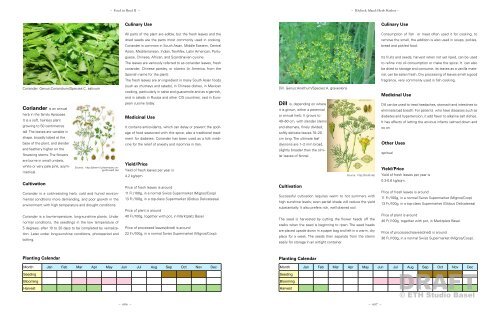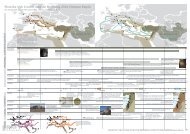BASEL-STADT: 4 PRoPoSALS - ETH Basel
BASEL-STADT: 4 PRoPoSALS - ETH Basel
BASEL-STADT: 4 PRoPoSALS - ETH Basel
Create successful ePaper yourself
Turn your PDF publications into a flip-book with our unique Google optimized e-Paper software.
Coriander. Genus:Coriandrum/Species:C. sativum<br />
Coriander is an annual<br />
herb in the family Apiaceae.<br />
It is a soft, hairless plant<br />
growing to 50 centimetres<br />
tall. The leaves are variable in<br />
shape, broadly lobed at the<br />
base of the plant, and slender<br />
and feathery higher on the<br />
flowering stems. The flowers<br />
are borne in small umbels,<br />
white or very pale pink, asymmetrical.<br />
Cultivation<br />
Coriander is a cold-resisting herb, cold and humid environmental<br />
conditions more demanding, and poor growth in the<br />
environment with high temperature and drought conditions.<br />
Coriander is a low-temperature, long-sunshine plants. Under<br />
normal conditions, the seedlings in the low temperature of<br />
5 degrees, after 10 to 20 days to be completed by vernalization.<br />
Later under long-sunshine conditions, photoperiod and<br />
bolting.<br />
Planting Calendar<br />
– Food in <strong>Basel</strong> II – – Klybeck Island: Herb Harbor –<br />
Month Jan Feb Mar Apr May Jun Jul Aug Sep Oct Nov Dec<br />
Seeding<br />
Blooming<br />
Harvest<br />
Source: http://pharm1.pharmazie.unigreifswald.de/<br />
Culinary Use<br />
All parts of the plant are edible, but the fresh leaves and the<br />
dried seeds are the parts most commonly used in cooking.<br />
Coriander is common in South Asian, Middle Eastern, Central<br />
Asian, Mediterranean, Indian, Tex-Mex, Latin American, Portuguese,<br />
Chinese, African, and Scandinavian cuisine.<br />
The leaves are variously referred to as coriander leaves, fresh<br />
coriander, Chinese parsley, or cilantro (in America, from the<br />
Spanish name for the plant).<br />
The fresh leaves are an ingredient in many South Asian foods<br />
(such as chutneys and salads), in Chinese dishes, in Mexican<br />
cooking, particularly in salsa and guacamole and as a garnish,<br />
and in salads in Russia and other CIS countries. sed in European<br />
cuisine today.<br />
Medicinal Use<br />
It contains antioxidants, which can delay or prevent the spoilage<br />
of food seasoned with this spice, also a traditional treatment<br />
for diabetes. Coriander has been used as a folk medicine<br />
for the relief of anxiety and insomnia in Iran.<br />
Yield/Price<br />
Yield of fresh leaves per year is<br />
4.2 kg/sqm.<br />
Price of fresh leaves is around<br />
11 Fr./100g, in a normal Swiss Supermarket (Migros/Coop)<br />
13 Fr./100g, in a top-class Supermarket (Globus Delicatessa)<br />
Price of plant is around<br />
40 Fr./100g, together with pot, in Marktplatz <strong>Basel</strong>.<br />
Price of processed leaves(dried) is around<br />
22 Fr./100g, in a normal Swiss Supermarket (Migros/Coop).<br />
Dill. Genus:Anethum/Species:A. graveolens<br />
Dill is, depending on where<br />
it is grown, either a perennial<br />
or annual herb. It grows to<br />
40–60 cm, with slender stems<br />
and alternate, finely divided,<br />
softly delicate leaves 10–20<br />
cm long. The ultimate leaf<br />
divisions are 1–2 mm broad,<br />
slightly broader than the similar<br />
leaves of fennel.<br />
Cultivation<br />
Successful cultivation requires warm to hot summers with<br />
high sunshine levels; even partial shade will reduce the yield<br />
substantially. It also prefers rich, well drained soil.<br />
The seed is harvested by cutting the flower heads off the<br />
stalks when the seed is beginning to ripen. The seed heads<br />
are placed upside down in a paper bag and left in a warm, dry<br />
place for a week. The seeds then separate from the stems<br />
easily for storage in an airtight container.<br />
Planting Calendar<br />
Month Jan Feb Mar Apr May Jun Jul Aug Sep Oct Nov Dec<br />
– 606 – – 607 –<br />
Seeding<br />
Blooming<br />
Harvest<br />
Source: http://biolib.de/<br />
Culinary Use<br />
Consumption of fish or meat often used it for cooking, to<br />
remove the smell, the addition is also used in soups, pickles,<br />
bread and pickled food.<br />
Its fruits and seeds, harvest when not yet riped, can be used<br />
to refine into oil consumption or make the spice. It can also<br />
be dried to storage and consume; its leaves as a vanilla material,<br />
can be eaten fresh. Dry processing of leaves smell a good<br />
fragrance, very commonly used in fish cooking.<br />
Medicinal Use<br />
Dill can be used to treat headaches, stomach and intestines to<br />
eliminate bad breath. For patients who have diseases such as<br />
diabetes and hypertension, it add flavor to alkaline salt dishes.<br />
It has effects of letting the anxious infants calmed down and<br />
so on.<br />
Other Uses<br />
spritual<br />
Yield/Price<br />
Yield of fresh leaves per year is<br />
0.3-0.6 kg/sqm.<br />
Price of fresh leaves is around<br />
11 Fr./100g, in a normal Swiss Supermarket (Migros/Coop)<br />
13 Fr./100g, in a top-class Supermarket (Globus Delicatessa)<br />
Price of plant is around<br />
40 Fr./100g, together with pot, in Marktplatz <strong>Basel</strong>.<br />
Price of processed leaves(dried) is around<br />
36 Fr./100g, in a normal Swiss Supermarket (Migros/Coop).<br />
DRAFT<br />
© <strong>ETH</strong> Studio <strong>Basel</strong>













